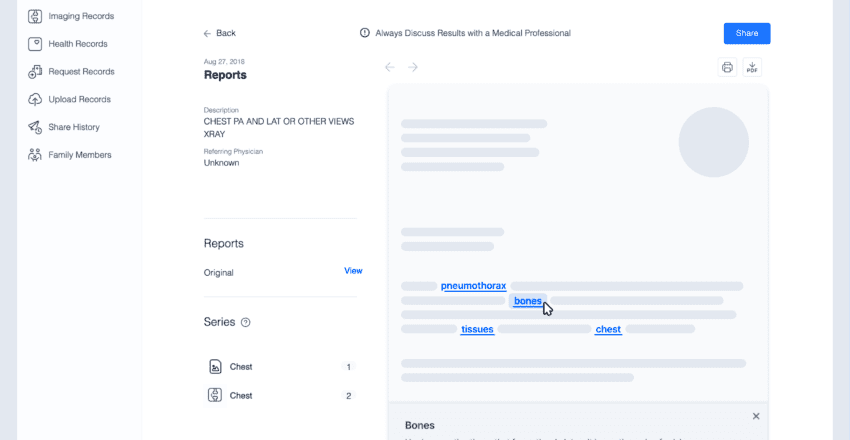Q&A: Behind the scenes of Report Reader
Published on: March 9, 2022 | PocketHealth
At PocketHealth, our mission is to help patients get more involved in their own care. A big part of that work is helping patients not only access, own and share their imaging, but understand their imaging as well. Our Report Reader feature was designed to do just that – take complicated medical terminology in their reports and make it easy for patients to understand, right in their PocketHealth account.
Read on to hear more about Report Reader from two of the PocketHealth team members that helped bring it to life – Kaelynd G, our product lead, and Grace C, a senior software engineer.
—
Why did we create Report Reader?
Kaelynd: Report Reader was born directly from patient feedback. Over the years, we constantly heard anecdotes from our patients like “It’s so nice to have my radiology reports, I wish I knew what they meant” or “It would be so nice if PocketHealth could translate these into layman’s terms”. At PocketHealth, we’re really focused on making sure that patients are at the center of their care journey. Giving patients access and ownership is the first step. Report Reader allows us to take this even further and actually educate patients.
Why did the team think Report Reader would be the right solution for our patients?
Kaelynd: Our team had been wanting to do something like this for a long time because we knew how valuable it would be for our patients. We really wanted to start providing our patients with a higher level of education. We had a few hypotheses of how we could provide this through the platform and as we explored those options, Report Reader seemed to resonate the most with our patients. It’s easy to access and interact with, we were able to embed it right into the reports and it’s free.
Grace: You open your exam and it’s right there. You can turn it off if you don’t want it, but it’s very easy for any patient to start using it immediately.
How long did it take to actually create the Report Reader tool?
Grace: A significant part of the work involved in bringing Report Reader to life was actually creating the list of terms to define. First, we had to do the work to understand what the most commonly used terms are, which we did using natural language processing. The process of identifying those terms was very automated, but it took our team a while to set it up.
Kaelynd: Once we had those terms, we compared them with a radiology dictionary to ensure that we were actually defining meaningful terms for our patients. “The” may have been the most common word in our reports, but that’s not a very helpful term to define for our patients!
Once we had narrowed down that list, we worked with an external physician to actually create the definitions. It was very important to us that anything we provided was clear, concise and accurate. Sometimes, Googling a term can be more confusing than the term itself and we wanted to avoid that.
Grace: Then we faced our biggest technical challenge, which was making sure that the actual technology that we developed to display the definitions themselves worked with each of our facilities’ reports. We learned very quickly that not all hospital reports have the same format, so we did a lot of testing and learning to ensure a seamless implementation no matter what hospital you request your records from.
Kaelynd: The whole process from beginning to end was around 5 months before we had something we felt like we were ready to bring to our patients.
How many terms can Report Reader define?
Kaelynd: We’re adding more all the time, but as of today, the tool has over 500 terms that it can define.
Grace: Most people will have around 11 terms that Report Reader can define in their reports – some may have more, some may have less.
Any ‘favourite’ terms that you learned the definition of along the way that you want to share?
Kaelynd: I was always surprised when I learned the definition of a word that might look a bit scary or intimidating, but it was just a factual word. For example, ‘parenchymal’ just means ‘relating to the parenchyma. Parenchyma is the tissue in the organ that performs the main function of the organ’
Grace: Mine was ‘hepatic’, which means ‘relating to the liver. The liver is a large organ in the upper right part of the abdomen. It has many important functions, including filtering blood, producing bile, and regulating metabolism’
What has working on Report Reader meant to you personally?
Grace: We had to invent something to make this happen – it wasn’t a typical challenge that we knew how to solve from the beginning. We had to create the solution from scratch. Not only was that part fun and challenging, but it’s especially meaningful when it has such an impact on our patients.
Kaelynd: Report Reader is very personal for me. I went through 3 years of ongoing health challenges that included a significant amount of medical imaging and trying to understand and access that imaging was so overwhelming for me. I would spend hours trying to understand my reports and learn more about my condition. That was actually how I came to work at PocketHealth. I was able to actually access and see my reports. When I look at my old reports now with Report Reader and I can see all the terms defined, I think about how much easier it would have been for me then and how much easier we are making it for patients going through a health challenge right now. It’s extremely rewarding for me.
—
We hope you enjoyed a sneak peak behind the scenes at PocketHealth!




